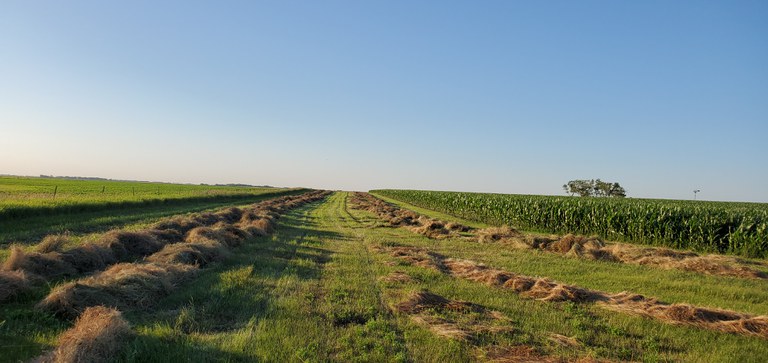Rain and Hay Making Don't Mix
The past few weeks have been difficult for baling hay. A few days of decent hay cutting weather has been followed by rain. And then some more rain. Seasoned hay professionals know ‘rained on’ hay has reduced yield and poorer feed value than hay with no rain. But how much is yield and quality reduced?
The following text is from an article by Mike Rankin and Dan Undersander, University of Wisconsin ‘Rain Damage to Forage During Hay and Silage Making’. The full piece can be found here: https://fyi.extension.wisc.edu/forage/rain-damage-to-forage-during-hay-and-silage-making/.
Rain that occurs between the time forage is cut and harvested causes both yield and quality losses that reduce the value of the crop as an animal feed and a marketable commodity. Weather-induced losses can be caused by:
- Increased and prolonged plant respiration that reduces soluble carbohydrates and the overall energy content of forage.
- Leaching of soluble carbohydrates, protein, and certain minerals.
- Leaf shattering and loss, removing the highly digestible and high protein portion of the forage.
- Microbial activity that metabolizes soluble carbohydrates, reduces forage energy content, and possibly produces harmful mycotoxins.
- Color bleaching.
How much does rainfall reduce yield?
Several research studies have addressed the effects of rainfall on cut alfalfa. In Wisconsin, Collins measured dry matter losses of 22% when alfalfa was exposed to 1-inch of rain after 1 day of curing. Similar hay cured without rain damage lost only 6.3% of the initial potential yield. Losses appear to be greatest after partial drying of the forage has occurred. In this same study, alfalfa exposed to 1.6 inches of rain over several days suffered a 44% loss in dry matter.
How does rainfall reduce yield?
Three primary factors are involved: leaching, respiration, and leaf loss.
- Leaching is the movement of cell solubles out of the plant. Components of the plant that are very water-soluble are leached out of the forage and lost during a rain event. Unfortunately, most of these compounds are those highly digested by the animal. They include such things as readily available carbohydrates and soluble nitrogen, minerals, and lipids. About one-half of the dry matter leached by rain is soluble carbohydrate. Excessive leaching of soluble carbohydrates by rainfall impacts its value to make good silage. Reduced soluble carbohydrates provide less substrate for bacteria involved in the fermentation process. In situations where soluble carbohydrates are in low concentrations, silage additives that provide fermentable substrate might provide some benefit to ensure proper fermentation.
- Respiration, the breakdown of soluble carbohydrates by plant enzymes, will cause dry matter losses regardless of whether wilted forage is subjected to rain or not. Respiration losses occur while crop moisture levels are above about 30 percent. These losses are reported to be about 3 to 4 percent of the potential DM harvest. Each time cut forages are wetted by rain, respiration is prolonged or begins again in cases where the cured forage is already below 30 percent moisture. In either situation, additional dry matter is lost.
- Experience and common sense tell us that rain damaged alfalfa is more susceptible to leaf shatter after it dries. Rainfall often means additional raking or tedding to speed up drying; hence, more lost leaves.

Windrows of drying hay, July 2019.
How does rainfall intensity and forage moisture affect losses?
Research is conclusive on these two points. Given the same amount of total rainfall, a low intensity rain will result in more leaching of soluble compounds than a high intensity rain. In addition, as forage moisture declines, it is more prone to DM loss from rain. In Wisconsin rainfall studies, the maximum loss in DM (54% DM loss) was a treatment where 2.5 inches of rain fell on hay that was nearly cured.
Does rainfall affect forage quality?
Perhaps nothing is more frustrating than to see excellent quality alfalfa turn into cordwood with each passing rainstorm and subsequent raking. Most rainfall studies agree that wetting of field cured alfalfa has little impact on crude protein concentration. In fact, it is common to see relatively high protein values in comparison to fiber concentrations. However, because rain leaches soluble carbohydrates, structural fibers (acid and neutral detergent fibers) comprise a greater percent of the forage dry matter. Depending on numerous factors previously discussed, the digestibility of rained-on hay may decline from 6 to 40 percent.
“Make hay while the sun shines” is an old adage that still rings true today. Watch the weather forecast and hope for better weather; or consider making haylage.
Karl Hoppe, Ph. D.
Karl.Hoppe@ndsu.edu
Livestock Extension Specialist


